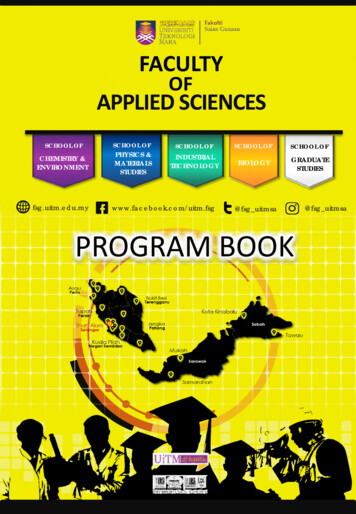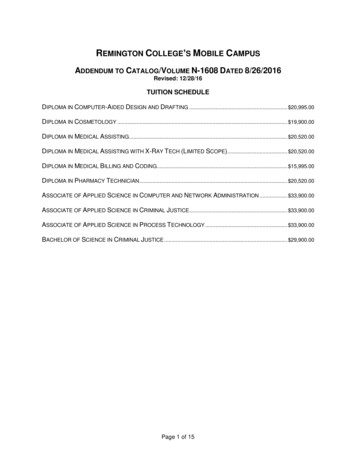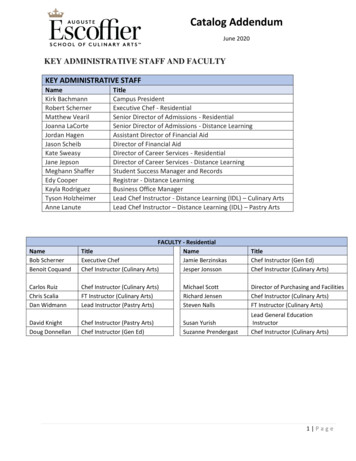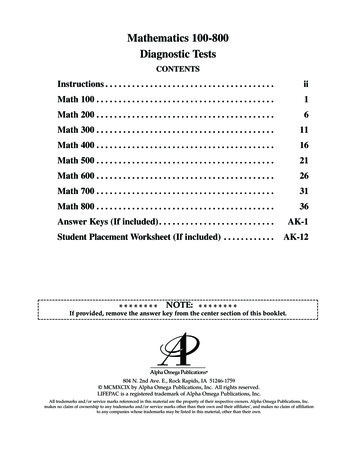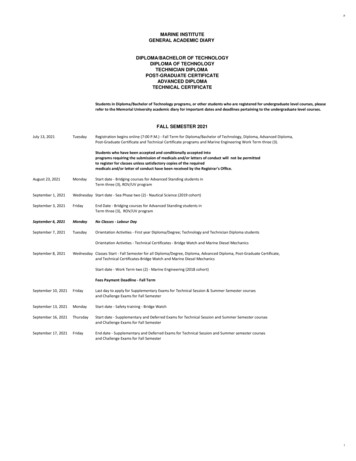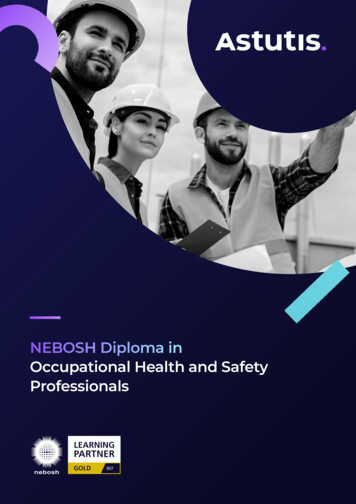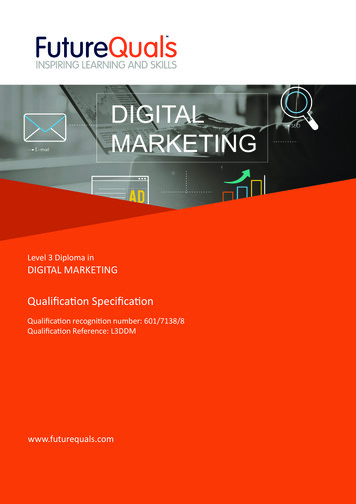
Transcription
Level 3 Diploma inDIGITAL MARKETINGQualification SpecificationQualification recognition number: 601/7138/8Qualification Reference: L3DDMwww.futurequals.com
This document is copyright under the Berne Convention. All rights are reserved. Apart from any fair dealing for thepurposes of private study, research, criticism or review, as permitted under the Copyright, Designs and Patents Act 1998,no part of this publication may be reproduced, stored in a retrieval system, or transmitted in any form or by any means,electronic, electrical, chemical, mechanical, optical, photocopying, recording or otherwise, without prior writtenpermission of the copyright owner. Enquiries should be addressed to Future Awards and Qualifications.Copyright Future (Awards and Qualifications) Ltd 2019
Version Control InformationDocument detailsDocument nameFAQ Level 3 Diploma in Digital Marketing - SpecificationPurpose of documentChange applied to existingversionDocument owner601/7138/8Qualification specification, component contents,assessment guidelines and information for centres.L3DDM V1 27/10/2017Product Development TeamVersion historyNew version numberafter amendmentDate amendedSectionDetails of change/s3DDM V1 27/10/2017August 2019ThroughoutAdministration updates,correcting typos, weblinks and AssessmentPrinciples.
ContentsCentre Requirements. 11.1 Introduction . 11.2 Data Protection . 21.3 Complaints . 21.4 Enquiries. 2Qualification Information . 32.1 Qualification Outline . 32.2 Additional Information . 32.3 Progression . 42.4 Assessment Principles . 42.5 Qualification Structure . 42.6 Barred Components and Exemptions . 6Assessment Principles and Component Specifications. 73.1 Assessment Principles . 7Introduction . 7External quality control. 7Assessing performance . 7Simulation of NVQ / SVQ components . 8Occupational expertise to assess performance, and moderate and verify assessments . 83.2 Component Specifications . 9Centre Information. 194.1 Centre Operations Manual . 194.2 Initial Assessment and Centre Learner Support . 194.3 Identification requirements and Learner Authenticity. 204.4 Legal Considerations . 21
Section OneCentre Requirements1.1 IntroductionIntroduction to FutureQualsFutureQuals is forward thinking, learner and customer-focused, and committed to deliveringinspiring learning and skills.Our Values“We are a Visionary, Supportive, Innovative and Professional Awarding Organisation that iscommitted to excellence.”Our Vision“We envisage a place in which every learner realises their full potential.”Our Mission“To provide respected and valued qualifications and assessment to enable quality assured learning.”FutureQuals is recognised to deliver regulated qualifications by Ofqual in England, CCEA Regulationin Northern Ireland, the Scottish Qualifications Authority (SQA Accreditation) and QualificationsWales to offer a comprehensive and diverse range of qualifications across a wide range of vocationalareas many of which are transferable across industries and sectors.A full list of FutureQuals current qualifications can be accessed at https://www.futurequals.comWe have developed a genuine understanding and insight into all types of educational organisations,which ensures that we are highly responsive to their needs. We offer a wide range of benefits andsupport for our learners, our approved centres, and their assessment and quality assurance teams.FutureQuals offers a wide range of benefits and support for all of our educational products andservices including: Vocational qualifications accredited by the UK regulators and recognised by employers,universities and professional bodies24/7 online management systems for the registration of learners, ensuring highly efficientservices and access to assessment and resultsA diverse range of qualificationsA flexible approach to assessmentA network of professionals who examine and quality assure our regulated qualifications andassessmentsRegular updates on new developments in education and trainingUnrivalled customer service support and extensive guidance materials.L3DDM V2 08/08/2019(601/7138/8) Qualification Specification 1
Introduction to Qualification SpecificationWelcome to the FutureQuals specification for the FAQ Level 3 Diploma in Digital Marketing.The aim of this specification is to provide our centres with guidance to assist in the administration,delivery and assessment of this qualification. It is recommended that you study this specification indetail and become fully conversant with the procedures and accompanying documents.This specification is a live document and, as such, will be updated when required. Centres will benotified when changes are made. It is the responsibility of the approved centre to ensure the mostup to date version of the Approved Specification is in use.This document is copyright but may be copied by approved centres for the purpose of assessinglearners. It may also be copied by learners for their own use.1.2 Data ProtectionFutureQuals is registered with the Data Protection Act and handles all data in accordance with therequired procedures of the Act.1.3 ComplaintsFutureQuals aims to constantly monitor the levels of service provided and report on performanceindicators on a regular basis. We will endeavour to be open about the levels of service we aim tooffer all our customers.However, if we fall short of expectations or our own standards, we want to give the opportunity forthose affected to provide feedback so we can put things right.Our Complaints Policy, which includes information on how to make a complaint, can be found on theFutureQuals website.1.4 EnquiriesAny enquires relating to this qualification should be addressed to:Future (Awards and Qualifications) LtdEMP HouseTelford WayCoalvilleLeicestershireLE67 3HETel: 01530 836662E-mail: qualifications@futurequals.comWebsite: https://www.futurequals.com/L3DDM V2 08/08/2019(601/7138/8) Qualification Specification 2
Section TwoQualification Information2.1 Qualification OutlinePurpose and AimsThe purpose of the FAQ Level 3 Diploma in Digital Marketing is to provide the learner with the skills,knowledge and understanding required to work in a digital marketing role.This qualification gives the learner an opportunity to: Understand the business environmentUnderstand legal, regulatory and ethical requirements in sales or marketingUse Collaborative TechnologiesUnderstand the principles of marketing and evaluationDevelop own professionalism skillsUnderstand digital marketing metrics and analyticsThe Total Qualification Time (TQT) for this qualification is: 740Guided Learning (GL) for this qualification is: 472 hoursMinimum credits required to achieve the qualification: 74Suitable for age ranges: 16-18, 19 Method of assessment: Portfolio of Evidence. This qualification is internally assessed and internallyquality assured by Centre staff and externally quality assured by FutureQuals External QualityAdvisors (EQAs).If the method of assessment includes formative assessments such as practical tasks, writtenquestions, multiple choice/short answer and knowledge assessment tasks where supervision of alearner assessment is required, assessment must be undertaken in line with the requirements set onin the FutureQuals Instructions for Conducting Controlled Assessments policy. This document ispublished on the Policies and Procedures section of the FutureQuals website.Grading: There is no specific grading criteria for this qualification.Entry guidance: There are no formal qualification entry requirements that a learner must havecompleted before taking this qualification and no requirement for learners to have prior skills,knowledge or understanding (Or add in reference to assessment strategy/principles, any otherqualifications the learner or prior knowledge and skills a learner is required to have/completedbefore taking the qualification).2.2 Additional InformationThis qualification is regulated by the Office of the Qualifications and Examinations Regulator(Ofqual) in England https://register.ofqual.gov.uk/,Qualifications Wales in WalesL3DDM V2 08/08/2019(601/7138/8) Qualification Specification 3
https://www.qiw.wales/, and CCEA Regulation in Northern Irelandhttp://ccea.org.uk/regulationIt may be eligible for public funding as determined by the Department for Education (DfE)underSections 96 and 97 of the Learning and Skills Act 2000, Qualification Wales and Departmentfor the Economy in Northern Ireland.For information regarding potential sources of funding please visit the following es/https://www.economy-ni.gov.uk/Alternativly , contact your local funding office.You should use the Qualification Accreditation Number (QAN) when you wish to seek publicfunding for your learners. Each component within a qualification will also have a uniquereference number (Component Reference Number), which is listed in this specification. Thequalification title and component reference numbers will appear on the learner’s finalcertification document. Learners need to be made aware of this detail when they arerecruited by the centre and registered with FutureQuals.2.3 ProgressionThe FAQ Level 3 Diploma in Digital Marketing has been specifically designed to support progressionon to other relevant qualifications including the Level 4 Diploma in Digital Marketing.2.4 Assessment PrinciplesThe FAQ The Level 3 Diploma in Digital Marketing must be assessed according to the InstructusAssessment Principles and Strategies.2.5 Qualification StructureTo achieve the FAQ Level 3 Diploma in Digital Marketing learners must achieve a minimum of 74credits. They must complete 6 mandatory components in Group M (27 credits). A minimum of 14credits must be achieved from Group O1. The remaining 33 credits can come from a combination ofGroup O1 and Group O2, or from Group O2 alone.Group M - MandatoryComponentNumber1URNComponent NameF/600/7799Understanding the BusinessEnvironmentL3DDM V2 08/08/2019CreditValue2Level2(601/7138/8) Qualification Specification 4
2F/502/8206Understanding Legal, Regulatory andEthical Requirements in Sales orMarketing223T/502/4380Using Collaborative Technologies634T/502/9935Principles of Marketing and Evaluation735L/505/1584Develop Own Professionalism436R/505/1585Digital Marketing Metrics and Analytics63Group O1 – Optional ComponentsURNComponent NameCreditValueLevelJ/503/9322Principles of Social Media Advertising and Promotion63Y/505/1586Search Engine Marketing53D/505/1587Content Marketing53H/505/1588Marketing on Mobile Devices53K/505/1589Online Display Advertising43D/505/1590E-mail Marketing63Group O2 – Optional ComponentsURNComponent NameL/502/4613Imaging Software42M/502/4393Video Software32F/502/4625Spreadsheet Software42R/503/9324Principles of Social Media within a Business63M/503/9329Principles of Keywords and Optimisation53H/503/9327Content Management System Website Creation73Y/502/4632Website Software53J/502/9938Principles of Marketing Stakeholder Relationships33H/505/1591Brand Development53K/505/1592Project Management43Y/601/2538Analyse and Report Data63M/505/1593Produce Copy for Digital Media Communication63T/502/4394Video Software43T/505/1594Delivering E-commerce Solutions93L3DDM V2 08/08/2019CreditValueLevel(601/7138/8) Qualification Specification 5
2.6 Barred Components and ExemptionsComponents with the same title at different levels, or components with the same content, cannot becombined in the same qualification.L3DDM V2 08/08/2019(601/7138/8) Qualification Specification 6
Section ThreeAssessment Principles and Component Specifications3.1 Assessment PrinciplesFutureQuals qualifications will always include Assessment Principles whether they have beendeveloped by a Sector Skills Council (SSC) or FutureQuals own. The latest version of the genericAssessment Principles are available on the FutureQuals website and should be used in conjunctionwith any qualification-specific assessment principles. You can view the principles Principles.pdf.Any Assessment Principles specific to a qualification will always be re-produced in the specificationthey relate to.Introduction1.1 The Marketing Assessment Strategy is designed to provide awarding organisationswith a robust and flexible approach to deliver assessment for Marketing NVQs / SVQsand competence-based qualifications.External quality control2.1 Awarding organisations will provide qualifications and quality assurance that supporttheir delivery to all Marketing NVQs / SVQs and competence-based qualificationassessment centres in line with regulatory requirements in England, Scotland, Wales andNorthern Ireland.2.2 Awarding organisations must use independent assessment 1 for NVQs / SVQs andcompetence based qualifications.2.3 Awarding organisations will supply SkillsCFA (CFA) with reports: Quarterly: provide registration and achievement data at component and qualification levelsAssessing performance3.1 Assessment of all components at any level of Marketing NVQs / SVQs andcompetence-based qualifications may be based on either candidate performance atwork or through simulation, as necessary (See Section 4 below).3.2 Components which have been imported by the CFA in their Marketing NVQs / SVQsand competencebased qualifications will be assessed in compliance with their relevantassessment strategies.1Independent assessment is assessment of candidates’ work that is carried out by assessors who do nothave a vested interest in the outcome.L3DDM V2 08/08/2019(601/7138/8) Qualification Specification 7
Simulation of NVQ / SVQ components4.1 If a component or part of a component at any level is simulated, it must beundertaken in a ‘realistic working environment’ (RWE).4.2 Awarding organisations will provide guidance for centres on RWEs. Awardingorganisations will make sure RWEs, “provide an environment which replicates the keycharacteristics of the workplace in which the skill to be assessed is normally employed”.Occupational expertise to assess performance, and moderate and verify assessments5.1 Candidates must be assessed, moderated or verified at work either by:a. Assessors, moderators or verifiers who have achieved or are working towardsachievement of the appropriate regulatory body approved component qualificationsfor assessment, moderation or verification;ORb. A trainer, supervisor or manager, employed by an organisation, who must either:1. Have achieved or be in the process of achieving the appropriate regulatory bodyapproved component qualifications for assessment, moderation or verification;or,2. Seek guidance and approval from an awarding organisation to demonstrate thatthe; o Organisation has appropriate processes in place to facilitate assessment,moderation or verification functionso Trainer, supervisor or manager is able to map their assessment, moderationor verification skills and knowledge 100% to the NOS upon which thequalifications above are based, and the A and V components. This is knownas the employer direct model in Scotland.5.2 Assessors must be occupationally competent to make Marketing assessmentjudgements about the level and scope of individual candidate performance atwork or in RWEs; and, occupationally competent to make assessmentjudgements about the quality of assessment and the assessment process.5.3 External Moderators / Verifiers or Internal Moderators / Verifiers must beoccupationally competent to make Marketing moderation and verificationjudgements about the quality of assessment and the assessment process.5.4 Awarding organisations will supply information on the requirements for internaland external moderation / verification activities to Marketing assessmentcentres.5.5 The sector requires all assessors, moderators and verifiers to maintain currentMarketing competence to deliver these functions. The CfA recognises this can beachieved in many ways but must be recorded in individual continual professionaldevelopment (CPD) records that are maintained in Marketing assessmentcentres.L3DDM V2 08/08/2019(601/7138/8) Qualification Specification 8
3.2 Component SpecificationsL3DDM V2 08/08/2019(601/7138/8) Qualification Specification 9
Component 1: Understanding the Business EnvironmentComponent Reference Number: F/600/7799Level: 2Credit: 2GL: 16024/Component SummaryThis component assesses the knowledge and understanding of different types of businesses andchanging patterns of employment.Learning Outcome - The learner will:1. Understand that there are different types ofbusiness.2. Understand how businesses function.3. Understand changing patterns ofemployment.4. Understand how business activity is affectedby market forces.L3DDM V2 08/08/2019Assessment Criterion - The learner can:1.1 Define the private sector and give examplesof types of private sector businesses.1.2 Define the public sector and give examplesof public sector organisations.1.3 Define the voluntary sector and giveexamples of voluntary sector organisations.1.4 Explain the possible advantages anddisadvantages of working in one of thefollowing sectors: private, public or voluntary.2.1 Describe the following business functions: Operations People Information Research and development Finance2.2 Compare the possible advantages anddisadvantages of working for a nationalorganisation and a Small and Medium-sizedEnterprise (SME).3.1 Outline some of the changes in patterns ofemployment locally.3.2 Outline some of the changes in patterns ofemployment nationally.3.3 Outline some of the changes in patterns ofemployment in Europe and globally.3.4 Describe how changing patterns ofemployment may affect his/her choices forlearning or work.4.1 Explain the relationship between supplyand demand in the business environment.4.2 Describe the relationship between priceand profit.4.3 Identify the connections between marketsand competition.(601/7138/8) Qualification Specification 10
Component 2: Understanding Legal, Regulatory and Ethical Requirements in Sales or MarketingComponent Reference Number: F/502/8206Level: 2Credit: 2GL: 15024/Component SummaryThis component assesses the knowledge and understanding of an organisation’s procedures fordealing with legal, regulatory and ethical requirements relating to sales or marketing.Assessment GuidanceAll Assessment Criteria must be met. The method of assessment is determined by individualawarding organisations.Relationship to Occupational StandardsThis component is linked to Council for Administration NOS SLS 77.Learning Outcome - The learner will:1. Understand an organisation’s procedures fordealing with legal, regulatory and ethicalrequirements relating to sales or marketing.2. Understand the legal, regulatory and ethicallimits of the sales or marketing role.L3DDM V2 08/08/2019Assessment Criterion - The learner can:1.1 Describe an organisation’s procedures forraising legal, regulatory and ethical concerns.1.2 Explain the scope of legal, regulatory andethical requirements in sales or marketing.1.3 Explain how the legal, regulatory andethical requirements relate to the business ofselling or marketing.1.4 Describe internal and external sources ofinformation on legal, regulatory and ethicalrequirements.1.5 Explain how an “ethical approach” affectsorganisations in the sales or marketingenvironment.1.6 Explain the importance of contract law insales.2.1 Explain the legal, regulatory and ethicalrequirements relevant to the role.2.2 Describe the potential consequences of notcomplying with legal, regulatory or ethicalrequirements.2.3 Explain the importance of working withinthe limits of the role, responsibilities andauthority.2.4 Explain the process for reporting legal,regulatory and ethical concerns.2.5 Explain the importance of clarity ofcommunication with the customer to ensurecommon understanding of agreements andexpectations.(601/7138/8) Qualification Specification 11
Component 3: Using Collaborative TechnologiesComponent Reference Number: T/502/4380Level: 3Credit: 6GL: 45024/Component SummaryThis component assesses the knowledge, skills and understanding required to use collaborativetechnologies.Assessment GuidanceSee IT User Assessment Strategy available from www.e-skills.com.Relationship to Occupational StandardsThis component is linked to the Level 3 National Occupational Standards for IT users devised by eSkills UK (Sector Skills Council for ICT).Learning Outcome - The learner will:1. Stay safe and secure when working withcollaborative technology.2. Plan and set up IT tools and devices forcollaborative working.L3DDM V2 08/08/2019Assessment Criterion - The learner can:1.1 Explain what and why guidelines need to beestablished for working with collaborativetechnology.1.2 Develop and implement guidelines for goodpractice in working with collaborativetechnology.1.3 Explain how to establish an identity orpresent information that will promote trust.1.4 Develop and implement guidelines forchecking the authenticity of identities anddifferent types of information.1.5 Analyse and plan for the risks in the use ofcollaborative technologies for different tasks.1.6 Analyse and manage risks in the use ofcollaborative technologies.2.1 Explain the features, benefits and limitationsof different collaborative IT tools and devices forwork purposes and tasks.2.2 Determine the IT tools and processes neededfor archiving the outcomes of collaborativeworking.2.3 Summarise ways to integrate differentcollaborative technology tools and devices for arange of purposes, tasks and communicationmedia.2.4 Explain potential access and compatibilityissues with integrating different collaborativetechnology tools and devices.(601/7138/8) Qualification Specification 12
3. Prepare collaborative technologies for use.4. Manage tasks using collaborativetechnologies.L3DDM V2 08/08/20192.5 Select, connect and configure combinationsthat exploit the capabilities and potential ofcollaborative tools and devices.2.6 Resolve access and compatibility problems sothat different collaborative tools and deviceswork successfully.3.1 Evaluate data management principles, issuesand methods.3.2 Manage levels of access and permissions fordifferent purposes.3.3 Select and integrate different elementsacross applications to create environments forcollaborative technologies.3.4 Set and adjust settings to facilitate use ofcollaborative technologies by others.3.5 Manage data flow to benefit collaborativeworking.4.1 Determine levels of responsibility for the useof collaborative technologies.4.2 Facilitate others’ responsible contributions toand engagement with collaborativetechnologies.4.3 Manage the moderation of collaborativetechnologies.4.4 Oversee the archiving of the outcomes ofcollaborative working.4.5 Explain what problems can occur withcollaborative technologies.4.6 Respond to problems with collaborativetechnologies and be prepared to help others todo so.(601/7138/8) Qualification Specification 13
Component 4: Principles of Marketing and EvaluationComponent Reference Number: T/502/9935Level: 3Credit: 7GL: 50024/Component SummaryThis component assesses the knowledge and understanding of the principles of marketsegmentation and marketing strategy development.Assessment GuidanceAll Assessment Criteria must be met. The method of assessment is determined by individualawarding organisations, in compliance with the CfA Sales Assessment Strategy.Relationship to Occupational StandardsThis component is linked to Council for Administration NOS. Marketing 1.3.1 Evaluate and interpret findings and identify connections in complex dataMarketing 1.3.3 Establish and understand potential market segmentsMarketing 1.3.4 Establish target market segments for products/services and evaluate theirpotentialMarketing 1.3.6 Analyse, interpret and synthesise data and research findings to inform socialmarketing strategySTC 2-1 Principles of marketing theoryMarketing 2.1.3 Demonstrate the value of marketing to the organisationMarketing 3.1.1 Develop marketing strategies and plans for products and servicesMarketing 4.2.6 Evaluate advertisingMarketing 6.2.1 Assess marketing opportunities within international and/or diverse markets.Learning Outcome - The learner will:1. Understand the principles of marketsegmentation.L3DDM V2 08/08/2019Assessment Criterion - The learner can:1.1 Explain the importance of defining marketsegments to the development andachievement of the marketing strategy.1.2 Explain the difference between marketsegments and customer classification.1.3 Explain how the characteristics, motivationsand behaviours of potential target customersare identified.1.4 Explain how to cluster customers withsimilar characteristics.1.5 Describe how to confirm that proposedsegments are real, distinctive, viable and theirbuying power measurable.1.6 Explain how to evaluate the profitabilityand stability of market segments.1.7 Describe how a range of products mayappeal to different market segments.(601/7138/8) Qualification Specification 14
2. Understand how to assess marketopportunities for new products and/or services.3. Understand the principles of marketingstrategy development.4. Understand how to evaluate theeffectiveness of a marketing strategy.L3DDM V2 08/08/20191.8 Explain the motivators and inhibitors thatinfluence customer behaviour.1.9 Explain the use of Customer RelationshipManagement.2.1 Describe the economic and buyerbehavioural factors to be taken into accountwhen assessing new market opportunities.2.2 Describe the cultural factors that are likelyto affect customers’ perception of productsand/or services and sales performance.2.3 Explain how to identify opportunities andthreats in new markets and for new products inexisting markets.2.4 Explain how competitor and potentialcompetitor activity may affect projected salesperformance.2.5 Explain the basis of recommendations toexploit new market opportunities.3.1 Describe the topics to be addressed in amarketing strategy.3.2 Explain the use of market analyses toinform the development of a marketingstrategy.3.3 Explain how to evaluate risks to theachievement of objectives.3.4 Describe how to forecast sales by productand/or service.3.5 Explain how to present a marketingstrategy including aims, objectives, actions,accountabilities, resources, budgets andforecasts.3.6 Explain the importance of engagingstakeholders in the development of amarketing strategy.3.7 Explain the significance of customer loyaltyto the achievement of marketing objectivesand strategy.3.8 Explain how to set performance indicatorsand evaluation arrangements that are capableof measuring returns on investment.4.1 Explain the importance of conducting theevaluation in accordance with the specification.4.2 Describe the factors to be taken intoaccount in the evaluation of the effectivenessof a marketing strategy.4.3 Explain the strengths and weaknesses ofdifferent evaluation methods.4.4 Describe how to identify trends and themesfrom evaluation data.4.5 Explain how to ensure the reliability andvalidity of evaluation data.(601/7138/8) Qualification Specification 15
4.6 Explain how to achieve an acceptable levelof statistical confidence.4.7 Explain how to address critical issuesrevealed by evaluation.4.8 Explain the importance of justifyingrecommendations and conclusions withevidence.4.9 Explain the use of impact analysis in theevaluation process.4.10 Explain the importan
J/502/9938 Principles of Marketing Stakeholder Relationships 3 3 H/505/1591 Brand Development 5 3 K/505/1592 Project Management 4 3 Y/601/2538 Analyse and Report Data 6 3 M/505/1593 Produce Copy for Digital Media Communication 6 3 T/502/4394 Video Software 4 3 T/505/1594 Delivering E-commerce Solutions 9 3 .

